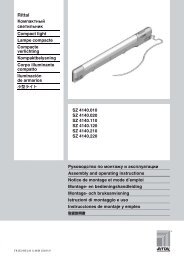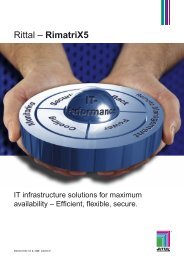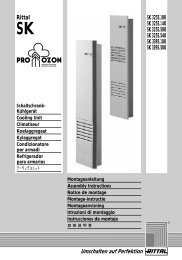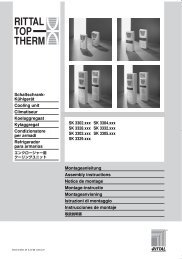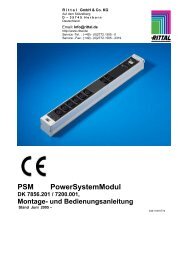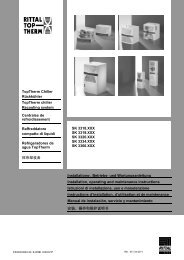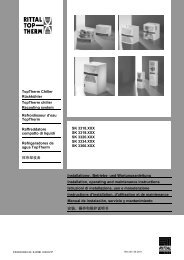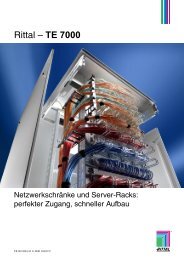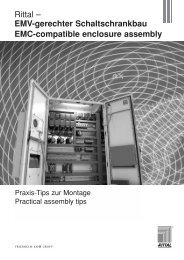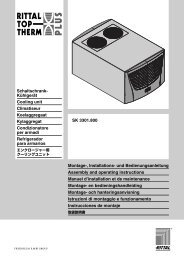- Page 1 and 2:
Rittal - IT Catalogue R
- Page 3 and 4:
CONTENTS Rittal IT catalogue Networ
- Page 5 and 6:
We give pioneering answers DETERMIN
- Page 7 and 8:
Rittal IT catalogue People are at t
- Page 9 and 10:
We hold face-to-face meetings . . .
- Page 11:
Rittal IT catalogue Rittal Internat
- Page 14 and 15:
Networking Networking System compar
- Page 16 and 17:
Networking Networking System compar
- Page 19:
TE 7000 Network enclosures Rittal I
- Page 22 and 23:
Networking Networking Parts list fo
- Page 24 and 25:
Wall-mounted enclosure, 3-part 1 2
- Page 26 and 27:
Networking Networking Network enclo
- Page 28 and 29:
Networking Networking Network enclo
- Page 30 and 31:
Networking Networking Network enclo
- Page 32 and 33:
Networking Networking Network enclo
- Page 34 and 35:
Networking Networking Network enclo
- Page 36 and 37:
Networking Networking Network enclo
- Page 38 and 39:
Networking Networking Network enclo
- Page 40 and 41:
Networking Networking Network enclo
- Page 42 and 43:
Networking Networking Network enclo
- Page 44 and 45:
Networking Networking Network enclo
- Page 46 and 47:
Networking Networking Network enclo
- Page 48 and 49:
Networking Networking Network enclo
- Page 50 and 51:
Networking Networking Network enclo
- Page 52 and 53:
Networking Networking Network enclo
- Page 54 and 55:
Networking Networking RNC universal
- Page 56 and 57:
Networking Networking Accessories f
- Page 58 and 59:
Networking Networking Wall-mounted
- Page 60 and 61:
Networking Networking Wall-mounted
- Page 62 and 63:
Networking Networking Wall-mounted
- Page 64 and 65:
Networking Networking Wall-mounted
- Page 66 and 67:
Networking Networking Wall-mounted
- Page 68 and 69:
Networking Networking Small fibre-o
- Page 70 and 71:
Networking Networking Fibre-optic m
- Page 73 and 74:
As different as our customers Ritta
- Page 75:
Rittal TS 8 TS 8 - The server rack
- Page 79 and 80:
TS 8 server rack 4 5 Rittal IT cata
- Page 81 and 82:
Rittal IT catalogue/Server racks Se
- Page 83 and 84:
TS 8 server rack, see page 85. Ever
- Page 85 and 86:
Material: Sheet steel Surface finis
- Page 87 and 88:
Design features ● Enclosure syste
- Page 89 and 90:
Smart Package A1 The solution for c
- Page 91:
Rittal IT catalogue/Server racks Sm
- Page 94 and 95:
Power Power Rittal IT power concept
- Page 96 and 97:
Power Power Power System Module PSM
- Page 98 and 99:
Power Power System network analysis
- Page 100 and 101:
Power Power Power System Module PSM
- Page 102 and 103:
Power Power Power System Module PSM
- Page 104 and 105:
Power Power UPS, Rittal Modular Pow
- Page 106 and 107:
Power Power UPS, Rittal Modular Pow
- Page 108 and 109:
Power Power Technical specification
- Page 110 and 111:
Power Power Static transfer switch
- Page 112 and 113:
112
- Page 114 and 115:
Cooling Cooling Passive cooling Pas
- Page 116 and 117:
Cooling 4 Cooling High-performance
- Page 118 and 119:
Cooling Cooling Examples Example: P
- Page 120 and 121:
Cooling Cooling Rack-mounted coolin
- Page 122 and 123:
Cooling Cooling Centrifugal fans, a
- Page 124 and 125:
Cooling Cooling Fan systems for TS
- Page 126 and 127:
Cooling Cooling Fan systems for TS/
- Page 128 and 129:
Cooling Cooling Fan systems for TS/
- Page 130 and 131:
Cooling Cooling Rittal Liquid Cooli
- Page 132 and 133:
Cooling Cooling Accessories for Rit
- Page 134 and 135:
Cooling Cooling Recooling systems f
- Page 136 and 137:
Cooling Cooling Fan-and-filter unit
- Page 138 and 139:
Cooling Cooling Roof-mounted coolin
- Page 140 and 141:
Cooling Cooling Air/water heat exch
- Page 142 and 143:
Cooling Cooling Accessories - Air r
- Page 144 and 145:
Cooling Cooling Accessories - Contr
- Page 146 and 147:
Cooling Cooling General accessories
- Page 148 and 149:
Cooling Cooling General accessories
- Page 150 and 151:
Cooling Cooling Climate control che
- Page 152 and 153:
152
- Page 154 and 155:
Security Security CMC-TC monitoring
- Page 156 and 157:
Security Security Monitoring system
- Page 158 and 159:
Security Security Basic module 1 2
- Page 160 and 161:
Security Security Sensor units 1 2
- Page 162 and 163:
Security Security Sensor units 5 Fa
- Page 164 and 165:
Security Security Accessory modules
- Page 166 and 167:
Security Security Connection/mounti
- Page 168 and 169:
Security Security Connection/mounti
- Page 170 and 171:
Security Security Connection/mounti
- Page 172 and 173:
Security Security Rack sensors Temp
- Page 174 and 175:
Security Security Universal sensors
- Page 176 and 177:
Security Security Power sensors Vol
- Page 178 and 179:
Security Security Access systems Ro
- Page 180 and 181:
Security Security Access systems Tr
- Page 182 and 183:
Security Security Access systems Sm
- Page 184 and 185:
Security Security Software CMC-TC M
- Page 186 and 187:
186
- Page 188 and 189:
Monitoring Monitoring Features of K
- Page 190 and 191:
Monitoring Monitoring Monitor/keybo
- Page 192 and 193:
Monitoring Monitoring KVM switches
- Page 194 and 195:
Monitoring Monitoring KVM switches
- Page 196 and 197:
Monitoring Monitoring KVM switches
- Page 198 and 199:
Monitoring Monitoring Software plan
- Page 200 and 201:
Monitoring Monitoring Software serv
- Page 203 and 204:
IT infrastructure - complete from R
- Page 205 and 206:
Your requirements ● Efficient, po
- Page 207 and 208:
Capacity 100 % 80 % 60 % 40 % 20 %
- Page 209 and 210:
In RimatriX5, Rittal offers its cus
- Page 211 and 212:
Strategy Control Your targets are m
- Page 213 and 214:
RISK PROTECTOR Lampertz Security Ro
- Page 215 and 216:
1 1 RISK PROTECTOR Lampertz Securit
- Page 217 and 218:
External dimensions mm Rittal IT ca
- Page 219 and 220:
Lampertz Basic Safe - The right dec
- Page 221 and 222:
Enormous flexibility for a wide ran
- Page 223 and 224:
Rittal IT catalogue/Telecom/Distrib
- Page 225 and 226:
Material: Side panels, roof and bas
- Page 227 and 228:
Material: Sheet steel, 1.5 mm Door:
- Page 229 and 230:
Rittal IT catalogue/Telecom/Distrib
- Page 231 and 232:
Supply includes: 1 torsionally stif
- Page 233 and 234:
Rittal IT catalogue/Telecom/Distrib
- Page 235 and 236:
Rittal IT catalogue/Telecom/Distrib
- Page 237 and 238:
Rittal IT catalogue/Telecom/Distrib
- Page 239 and 240:
Complete, systematic know-how Indoo
- Page 241 and 242:
Rittal’s Electronics Division: Ri
- Page 243 and 244:
Rittal Electronic Systems Integrati
- Page 245 and 246:
Every Interactive Terminal System I
- Page 247 and 248:
Ingenious - the PC flap Install, se
- Page 249 and 250:
CS modular enclosures Standard encl
- Page 251 and 252:
Application: Outdoor emergency powe
- Page 253 and 254:
System accessories Base from page 2
- Page 255 and 256:
Rittal IT catalogue/System accessor
- Page 257 and 258:
Rittal IT catalogue/System accessor
- Page 259 and 260:
Rittal IT catalogue/System accessor
- Page 261 and 262:
1 2 3 4 Rittal IT catalogue/System
- Page 263 and 264:
Rittal IT catalogue/System accessor
- Page 265 and 266:
The TS side panel provides new dime
- Page 267 and 268:
Rittal IT catalogue/System accessor
- Page 269 and 270:
Rittal IT catalogue/System accessor
- Page 271 and 272:
6 Rittal IT catalogue/System access
- Page 273 and 274:
Rittal IT catalogue/System accessor
- Page 275 and 276:
Rittal IT catalogue/System accessor
- Page 277 and 278:
Rittal IT catalogue/System accessor
- Page 279 and 280:
101 500 115 Rittal IT catalogue/Sys
- Page 281 and 282:
Rittal IT catalogue/System accessor
- Page 283 and 284:
120° 64 Position for door opening
- Page 285 and 286:
Rittal IT catalogue/System accessor
- Page 287 and 288:
Rittal IT catalogue/System accessor
- Page 289 and 290:
Rittal IT catalogue/System accessor
- Page 291 and 292:
200 606 B - 88 B - 3 512 150 Rittal
- Page 293 and 294:
Roof-mounted fan for TS, FR(i) For
- Page 295 and 296:
Overview of TS installation systems
- Page 297 and 298:
Attachment may be made at any point
- Page 299 and 300:
Rittal IT catalogue/System accessor
- Page 301 and 302:
Rittal IT catalogue/System accessor
- Page 303 and 304:
Rittal IT catalogue/System accessor
- Page 305 and 306:
Rittal IT catalogue/System accessor
- Page 307 and 308:
Rittal IT catalogue/System accessor
- Page 309 and 310:
1 2 Rittal IT catalogue/System acce
- Page 311 and 312:
Rittal IT catalogue/System accessor
- Page 313 and 314:
Rittal IT catalogue/System accessor
- Page 315 and 316:
Rittal IT catalogue/System accessor
- Page 317 and 318:
3 Rittal IT catalogue/System access
- Page 319 and 320:
1 Spacers 2 Telescopic slides 3 Ada
- Page 321 and 322:
Interior installation Component she
- Page 323 and 324:
Rittal IT catalogue/System accessor
- Page 325 and 326:
Rittal IT catalogue/System accessor
- Page 327 and 328:
Rittal IT catalogue/System accessor
- Page 329 and 330:
Technical properties depending on v
- Page 331 and 332:
Rittal IT catalogue/System accessor
- Page 333 and 334:
A A Side attachment B Rear attachme
- Page 335 and 336:
Rittal IT catalogue/System accessor
- Page 337 and 338:
Rittal IT catalogue/System accessor
- Page 339 and 340:
Rittal IT catalogue/System accessor
- Page 341 and 342:
Rittal IT catalogue/System accessor
- Page 343 and 344:
Size 3 Size 4 45 7.5 Size 5 120 Ø
- Page 345 and 346:
16.5 Size Design For 16.5 3 160 133
- Page 347 and 348:
Rittal IT catalogue/System accessor
- Page 349 and 350:
Rittal IT catalogue/System accessor
- Page 351 and 352:
Rittal IT catalogue/System accessor
- Page 353 and 354:
Rittal IT catalogue/System accessor
- Page 355 and 356:
Rittal IT catalogue/System accessor
- Page 357 and 358:
Rittal IT catalogue/System accessor
- Page 359 and 360:
Rittal IT catalogue/System accessor
- Page 361 and 362:
Rittal IT catalogue/System accessor
- Page 363 and 364:
Rittal IT catalogue/System accessor
- Page 365 and 366:
Rittal IT catalogue/System accessor
- Page 367 and 368:
1 3 43 63 Rittal IT catalogue/Syste
- Page 369 and 370:
Rittal IT catalogue/System accessor
- Page 371 and 372:
Rittal IT catalogue/System accessor
- Page 373 and 374:
Rittal IT catalogue/System accessor
- Page 375 and 376:
Installation depth T max. = mm with
- Page 377 and 378:
Rittal IT catalogue/System accessor
- Page 379 and 380:
Rittal IT catalogue/System accessor
- Page 381 and 382:
Rittal IT catalogue/System accessor
- Page 383 and 384:
Rittal IT catalogue/System accessor
- Page 385 and 386:
Rittal IT catalogue/System accessor
- Page 387 and 388: Rittal IT catalogue/System accessor
- Page 389 and 390: L1 L3 13+0.1 3.2 14.8+0.1 20.1+0.1
- Page 391 and 392: 18 13.5+0.1 4 2.5 (6 x) 9.6+0.1 12.
- Page 393 and 394: Rittal IT catalogue/System accessor
- Page 395 and 396: Rittal IT catalogue/System accessor
- Page 397 and 398: Rittal IT catalogue/System accessor
- Page 399 and 400: 399
- Page 401 and 402: Fully programmed for service Not on
- Page 403 and 404: Rittal IT catalogue/Engineering/Con
- Page 405 and 406: Rittal IT catalogue/Engineering/Con
- Page 407 and 408: Basic guide to the selection of cli
- Page 409 and 410: What is meant by EMC? Electromagnet
- Page 411 and 412: Earthquake risk Enclosures which ar
- Page 413 and 414: Mounting angles Z V V V Y W Cranked
- Page 415 and 416: Clarification of the term “UPS”
- Page 417 and 418: Rittal IT catalogue/Engineering/Con
- Page 419 and 420: D max. D3 min. D4 min. S R 1 1 W2 W
- Page 421 and 422: Protection categories to EN 60 529/
- Page 423 and 424: Benefits: ● Configured to order
- Page 425 and 426: Benefits: Unlimited applications co
- Page 427 and 428: Material: Sheet steel Surface finis
- Page 429 and 430: Material: Sheet steel Surface finis
- Page 431 and 432: Rittal IT News/Server racks Server
- Page 433 and 434: DK 7857.430, DK 7857.431, DK 7857.4
- Page 435 and 436: For office applications. Special in
- Page 437: The wireless access sensor reports
- Page 441 and 442: USB web camera available on request
- Page 443 and 444: Rittal IT News/Security CMC-TC leak
- Page 445 and 446: IP-Cam CMC-TC TCP/IP Rittal IT News
- Page 447 and 448: Rittal IT News/Monitoring SSC Conne
- Page 449 and 450: Rittal IT News/System accessories O
- Page 451 and 452: Rittal IT News/System accessories B
- Page 453 and 454: 13 = B1 B = Width T = Depth B2 Ritt
- Page 455 and 456: 1 2 3 Rittal IT News/System accesso
- Page 457 and 458: Rittal IT News/System accessories N
- Page 459 and 460: Rittal IT News/System accessories S
- Page 461 and 462: Model No. Page 1101.800 289 1581.00
- Page 463 and 464: Model No. Page 4138.150 334 4138.18
- Page 465 and 466: Model No. Page 7320.630 172 7320.63
- Page 467 and 468: Model No. Page 7827.140 364 7827.14
- Page 469 and 470: Model No. Page 8612.000 299, 324, 3
- Page 471 and 472: CS - Enclosure light 48 V DC 335 -
- Page 473 and 474: Side panels 265 - 267 - for TC rack
- Page 475 and 476: Germany Rittal GmbH & Co. KG Postfa



